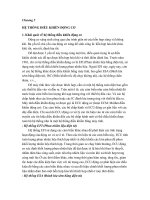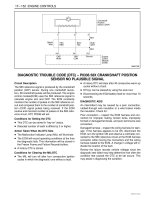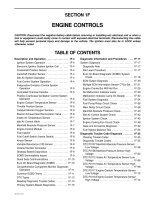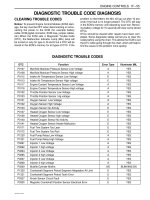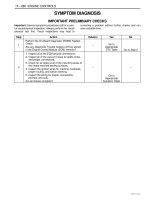HỆ THỐNG điều KHIỂN ĐỘNG cơ TRÊN XE TOYOTA
Bạn đang xem bản rút gọn của tài liệu. Xem và tải ngay bản đầy đủ của tài liệu tại đây (1.95 MB, 45 trang )
Section 3
Ignition Systems
Engine Control Systems I - Course 852
Lesson Objectives 1. Determine the condition of the ignition system based on relevant input
sensor signals and output signals
2. Determine the root cause of a failure(s) in the ignition system using
appropriate diagnostic procedures
T852f129
MAF Meter (MAP)
Camshaft & Crankshaft Sensors
Engine Coolant Temperature Sensor
Throttle Position Sensor
Ignition Switch (ST Terminal)
Check Connector
Igniter
Ignition Coil
Distributor
Spark Plugs
ECM
VG (PIM)
IGF
IGT
NE
G1
THW
VTA (IDL)
STA
T
The purpose of the ignition system is to ignite the air/fuel mixture in
the combustion chamber at the proper time. In order to maximize
engine output efficiency, the air-fuel mixture must be ignited so that
maximum combustion pressure occurs at about 10º after top dead cen-
ter (TDC).
However, the time from ignition of the air-fuel mixture to the develop-
ment of maximum combustion pressure varies depending on the engine
speed and the manifold pressure; ignition must occur earlier when the
engine speed is higher and later when it is lower. In early systems, the
timing is advanced and retarded by a governor in the distributor.
Section 3
Ignition Systems
Engine Control Systems I - Course 852
3-1
Ignition
System
Overview
Combustion
Pressure and
Duration
Fig. 3-01
T852f125/T852f126
➀
Ignition
➁
Combustion Start (Flame Propagation Start)
➂
Maximum Combustion Pressure
➃
End of Combustion
COMBUSTION PROCESS
Compression Only
Pressure
1
3
4
2
BTDC TDC ATDC
Ignition
10º BTDC
Maximum
Cylinder Pressure
10º ATDC
.003
Sec.
1000 RPM
TOYOTA Technical Training
3-2
Section 3
Furthermore, ignition must also be advanced when the manifold pres-
sure is low (i.e. when there is a strong vacuum). However, optimal igni-
tion timing is also affected by a number of other factors besides engine
speed and intake air volume, such as the shape of the combustion
chamber, the temperature inside the combustion chamber, etc. For
these reasons, electronic control provides the ideal ignition timing for
the engine.
Ignition Advance
Ignition must occur
earlier so that the
cylinder achieves
maximum cylinder
pressure as engine
RPMs increase.
Fig. 3-02
T852f127/T852f128
➀
Ignition
➁
Combustion Start (Flame Propagation Start)
➂
Maximum Combustion Pressure
➃
End Of Combustion
COMBUSTION PROCESS
Pressure
3
4
2
1
10º
Advanced
Angle
BTDC TDC ATDC
Compression
Only
Ignition
28º BTDC
Maximum
Cylinder Pressure
10º ATDC
.003
Sec.
2000 RPM
Engine Control Systems I - Course 852
3-3
Ignition Systems
In the Electronic Spark Advance (ESA) system, the engine is provided
with nearly ideal ignition timing characteristics. The ECM determines
ignition timing based on sensor inputs and on its internal memory, which
contains the optimal ignition timing data for each engine running condi-
tion. After determining the ignition timing, the ECM sends the ignition
Timing signal (IGT) to the igniter. When the IGT signal goes off, the Igniter
will shut off primary current flow in the ignition coil producing a high
voltage spark (7kV - 35kV) in the cylinder.
Since the ESA always ensures optimal ignition timing, emissions are low-
ered and both fuel efficiency and engine power output are maintained at
optimal levels.
Ignition systems are divided into three basic categories:
• Distributor.
• Distributorless Ignition System (DLI) Electronic Ignition.
• Direct Ignition System (DIS).
ESA Block Diagram
The distributor is not used on
Distributorless and Direct Ignition Systems.
Types of Ignition
Systems
Fig. 3-03
T852f129
Electronic
Spark
Advance
Overview
MAF Meter (MAP)
Camshaft & Crankshaft Sensors
Engine Coolant Temperature Sensor
Throttle Position Sensor
Ignition Switch (ST Terminal)
Check Connector
Igniter
Ignition Coil
Distributor
Spark Plugs
ECM
VG (PIM)
IGF
IGT
NE
G1
THW
VTA (IDL)
STA
T
TOYOTA Technical Training
3-4
Section 3
Regardless of type the essential components are:
• Crankshaft sensor (Ne signal).
• Camshaft sensor (also called Variable Valve Timing sensor)
(G signal).
• Igniter.
• Ignition coil(s), harness, spark plugs.
• ECM and inputs.
The ignition coil must generate enough power to produce the spark
needed to ignite the air/fuel mixture. To produce this power, a strong
magnetic field is needed. This magnetic field is created by the current
flowing in the primary coil. The primary coil has a very low resistance
(approximately 1-4 ohms) allowing current flow. The more current, the
stronger the magnetic field. The power transistor in the igniter handles
the high current needed by the primary coil.
Another requirement to produce high voltages is that the current flow in
the primary coil must be turned off quickly. When the transistor in the
igniter turns off, current flow momentarily stops and the magnetic field
collapses. As the rapidly collapsing magnetic field passes through the
secondary winding, voltage (electrical pressure) is created. If sufficient
voltage is created to overcome the resistance in the secondary circuit,
there will be current flow and a spark generated.
Ignition Spark
Generation
Essential
Ignition System
Components
Fig. 3-04
T852f130
Ignition Spark Generation
Spark Plug
Primary Current
Ignition Coil
Power Transistor
Igniter
IGF
Various Sensors
IGT
ECM
NE
G —
G1
Engine Control Systems I - Course 852
3-5
Ignition Systems
The higher the resistance in the secondary circuit, the more voltage that
will be needed to get the current to flow and the shorter spark duration.
This is important when observing the ignition spark pattern.
The primary coil current flow is controlled by the ECM through the
Ignition Timing (IGT) signal. The IGT signal is a voltage signal that turns
on/off the main transistor in the igniter. When IGT signal voltage drops to
0 volts, the transistor in the igniter turns off. When the current in the
primary coil is turned off, the rapidly collapsing magnetic field induces a
high voltage in the secondary coil. If the voltage is high enough to over-
come the resistance in the secondary circuit, there will be a spark at the
spark plug.
On some ignition systems, the circuit that carries the primary coil current
is called IGC. IGC is turned on and off by the igniter based on the IGT
signal.
IGT Signal
The IGT signal
determines when
ignition will occur.
Fig. 3-05
T852f131
IGC
Fig. 3-06
T852f132
IGT Signal
IGC
From Battery
ECM IGT IGCIgniter
Ignition
Coil
Ignition
TDC
Ignition Timing
Primary Current
Advanced Angle
IGT
NOTE
TOYOTA Technical Training
3-6
Section 3
The primary function of the igniter is to turn on and off the primary coil
current based on the IGT signal received from the ECM. The igniter or
ECM may perform the following functions:
• Ignition Confirmation (IGF) signal generation unit.
• Dwell angle control.
• Lock prevention circuit.
• Over voltage prevention circuit.
• Current limiting control.
• Tachometer signal.
It is critical that the proper igniter is used when replacing an igniter.
The igniters are matched to the type of ignition coil and ECM.
The IGF signal is used by the ECM to determine if the ignition system is
working. Based on IGF, the ECM will keep power supplied to the fuel
pump and injectors on most ignition systems. Without IGF, the vehicle
will start momentarily, then stall. However, with some Direct
Ignition Systems with the igniter in the coil, the engine will run.
Igniter
Fig. 3-07
T852f133
IGF Signal
IGF Signal
Ignition
Coil
Ignition
Switch
Battery
To Spark Plugs
Igniter
IGF Signal
Generation
Circuit
Ignition
Control Circuit
Micro
Processor
IGF
IGT
ECM
There are two basic methods of detecting IGF. Early systems used the
Counter Electromotive Force (CEMF) created in the primary coil and cir-
cuit for generating the IGF signal. The collapsing magnetic field produces
a CEMF in the primary coil. When CEMF is detected by the igniter, the
igniter sends a signal to the ECM. This method is no longer used.
The primary current level method measures the current level in the pri-
mary circuit. The minimum and maximum current levels are used to turn
the IGF signal on and off. The levels will vary with different ignition sys-
tems. Regardless of method, the Repair Manual shows the scope pattern
Engine Control Systems I - Course 852
3-7
Ignition Systems
IGF Detection
through Primary Current
I
1
Primary current
I
A
Maximum current level for successful spark generation
I
B
Minimum current level for successful spark generation
Fig. 3-08
T852f134
IGF Signal Detection Using CEMF
IGF Signal Detection
using CEMF
IGF Detection Using
Primary Current
Method
Fig. 3-09
T852f135/T852f136
T852f137
IGT
**
ON
OFF
ON
OFF
12V
0
Primary
Voltage
IGF
*The Counter Electromotive Force
IGT
I
1
IGF
IGT
I
1
IGF
IGT
I
1
IGF
1
A
1
B
1
A
1
B
1
B
Constant
Time
TOYOTA Technical Training
3-8
Section 3
or provides you with the necessary voltage reading to confirm that the
igniter is producing the IGF signal.
Lack of an IGF on many ignition systems will produce a DTC. On some
ignition systems, the ECM is able to identify which coil did not produce
an IGF signal and this can be accomplished by two methods.
The first method uses an IGF line for each coil.
With the second method, the IGF signal is carried back to the ECM on a
common line with the other coil(s). The ECM is able to distinguish
which coil is not operating based on when the IGF signal is received.
Since the ECM knows when each cylinder needs to be ignited, it knows
from which coil to expect the IGF signal.
IGF Circuit (8 Cylinder Engine)
Note that there are only two IGF lines for
eight cylinders. Because the ECM knows
when the coil is triggered, it knows when to
expect the IGF signal. This
capability allows the ECM to correctly
identify the cylinder and set the
appropriate DTC.
Fig. 3-10
T852f138
Camshaft
Position
Sensor
G2
ECM
+B
IGT 1
IGT 2
IGT 3
IGT 4
IGT 5
IGT 6
IGT 7
IGT 8
IGF 1
IGF 2
NE
Crankshaft
Position
Sensor
Various
Sensors
Ignition Coil (With Igniter)
No. 1 Cylinder
No. 2 Cylinder
No. 3 Cylinder
No. 4 Cylinder
No. 5 Cylinder
No. 6 Cylinder
No. 7 Cylinder
No. 8 Cylinder
This circuit controls the length of time the power transistor (current flow
through the primary circuit) is turned on.
The length of time during which current flows through the primary coil
generally decreases as the engine speed rises, so the induced voltage in
the secondary coil decreases.
Dwell angle control refers to electronic control of the length of time during
which primary current flows through the ignition coil (that is, the dwell
angle) in accordance with distributor shaft rotational speed.
At low speeds, the dwell angle is reduced to prevent excessive primary
current flow, and increased as the rotational speed increases to prevent
the primary current from decreasing.
This circuit forces the power transistor to turn off if it locks up (if current
flows continuously for a period longer than specified), to protect the igni-
tion coil and the power transistor.
This circuit shuts off the power transistor(s) if the power supply voltage
becomes too high, to protect the ignition coil and the power transistor.
Engine Control Systems I - Course 852
3-9
Ignition Systems
Lock Prevention
Circuit
Over Voltage
Prevention Circuit
Dwell Angle Control
Fig. 3-11
T852f139/T852f140
Dwell Angle Control
RPM
RPM
40
30
20
10
0
80
60
40
0
With Dwell Angle Control
Without Dwell Angle Control
Generated Voltage (kV)
Dwell Angle (Degrees)
TOYOTA Technical Training
3-10
Section 3
Current limiting control is a system that improves the rise of the flow of
current in the primary coil, ensuring that a constant primary current is
flowing at all times, from the low speed to the high speed range, and
thus making it possible to obtain a high secondary voltage.
The coil's primary resistance is reduced improving the current rise per-
formance, and this will increase the current flow. But without the cur-
rent limiting circuit, the coil or the power transistor will burn out. For
this reason, after the primary current has reached a fixed value, it is
controlled electronically by the igniter so that a larger current will not
flow.
Since the current-limiting control limits the maximum primary current,
no external resistor is needed for the ignition coil.
Since igniters are manufactured to match ignition coil characteris-
tics, the function and construction of each type are different. For
this reason, if any igniter and coil other than those specified are
combined, the igniter or coil may be damaged. Therefore, always
use the correct parts specified for the vehicle.
On some systems the Tach signal is generated in the igniter.
Though there are different types of ignition systems, the use of the NE
and G signals is consistent. The NE signal indicates crankshaft position
and engine RPM.
Tachometer Signal
NE Signal and
G Signal
Fig. 3-12
T852f141
NOTE
Current
Limiting (Over
Current Prevention)
Current Limiting
(Over Current
Prevention)
Transistor
Time
ON
OFF
Conventional
Ignition Coil
Ignition Coil with
Current Limiting Circuit
Current Limitations
Primary Current
CURRENT LIMITING CONTROL
NOTE
Engine Control Systems I - Course 852
3-11
Ignition Systems
The G signal (also called VVT signal) provides cylinder identification. By
comparing the G signal to the NE signal, the ECM is able to identify the
cylinder on compression. This is necessary to calculate crankshaft angle
(initial ignition timing angle), identify which coil to trigger on Direct
Ignition System (independent ignition), and which injector to energize on
sequential fuel injection systems.
As ignition systems and engines evolved, there have been modifications to
the NE and G signal. Timing rotors have different numbers of teeth. For
some G signal sensors, a notch is used instead of a tooth to generate a
signal. Regardless, you can determine what style is used by visually
examining the timing rotor or consulting the Repair Manual. Many of the
different styles are represented with their respective ignition system.
For maximum engine output efficiency, the air/fuel mixture must be
ignited so that maximum combustion pressure occurs approximately 10º-
15º after TDC. As engine RPM increases, there is less time for the mixture
to complete its combustion at the proper time because the piston is trav-
eling faster. The ECM controls when the spark occurs through the IGT
signal. By varying the time the IGT signal is turned off, the ECM changes
ignition spark timing.
Ignition
Advance Angle
As engine RPM
increases, ignition must
begin earlier.
Electronic Spark
Advance
Operation
Fig. 3-13
T852f142
Ignition
IGT
Advanced
Angle
Initial Ignition Timing 5º, 7º, or 10º
BTDC
(Depending on Engine Model)
TDC
TOYOTA Technical Training
3-12
Section 3
Ignition timing control consists of two basic elements:
• Ignition control during starting.
• After-start ignition control.
Ignition control during starting is defined as the period when the engine
is cranking and immediately following cranking. The ignition occurs at a
fixed crankshaft angle, approximately 5º-10º BTDC, regardless of engine
operating conditions and this is called the initial timing angle.
Since engine speed is still below a specified RPM and unstable during
and immediately after starting, the ignition timing is fixed until engine
operation is stabilized.
The ECM recognizes the engine is being cranked when it receives the NE
and G signal. On some models, the starter (STA) signal is also used to
inform the engine is being cranked.
Starting
Ignition Control
Ignition Control
During Starting
Ignition Advance
Modes and Corrections
The ECM calculates the IGT signal on time
based on engine operating modes and
conditions. The IGT signal is based
primarily on the crankshaft position sensor
signal, engine load, temperature, knock
sensor, etc.
Ignition
Timing
Control
Starting Ignition Control Initial Ignition Timing Angle
Basic Ignition Advance Angle
Corrective Ignition Advance Control
After-Start Ignition Control
Initial Ignition Timing Angle
Warm-Up Correction
Over-Temperature Correction
Stable Idling Correction
EGR Correction
Air/Fuel Ratio Feedback Correction
Knocking Correction
Torque Control Corrections
Other Corrections
Maximum And Minimum Advance Angle Control
Fig. 3-14
Engine Control Systems I - Course 852
3-13
Ignition Systems
After-start ignition control will calculate and adjust ignition timing based
on engine operating conditions. The calculation and adjustment of igni-
tion timing is performed in a series of steps, beginning with basic ignition
advance control.
Various corrections are added to the initial ignition timing angle and the
basic ignition advance angle during normal operation.
After-start ignition control is carried out during normal operation.
Initial Ignition Timing Angle
This angle is calculated from the first NE
signal that follows a G signal. The ignition
occurs at a fixed crankshaft angle,
approximately 5º-10º BTDC, regardless of
engine operating conditions, and this is
called the initial timing angle.
Initial Ignition
Timing Angle Symbol
Fig. 3-15
T852f143/T852f144
Fig. 3-16
T852f145
Initial Ignition Timing Angle
After-Start Ignition
Control
G Signal Timing
Rotor And G
Pickup Coil
NE Signal Timing
Rotor And NE
Pickup Coil
Timing Rotor
Point A
Point B
G Signal
5°, 7°, or 10° BTDC
5°, 7°, or 10° BTDC
5°, 7°, or 10° BTDC
NE
TDC
Point A
Point B
Ignition
Ignition
IGT With Initial Ignition Timing
IGT With Timing Advanced
TOYOTA Technical Training
3-14
Section 3
The various corrections (that are based on signals from the relevant
sensors) are added to the initial ignition timing angle and to the basic
ignition advance angle (determined by the intake air volume signal or
intake manifold pressure signal) and by the engine speed signal:
Ignition timing = initial ignition timing angle
+ basic ignition advance angle
+ corrective ignition advance angle
During normal operation of after-start ignition control, the Ignition
Timing (IGT) signal calculated by the microprocessor in the ECM and is
output through the back-up IC.
The ECM selects the basic ignition advance angle from memory based
on engine speed, load, throttle valve position, and engine coolant tem-
perature.
Relevant Signals:
• Intake air volume (VS, KS, or VG) (Intake manifold pressure (PIM)).
• Engine speed (NE).
• Throttle position (IDL).
• Engine Coolant Temperature (THW).
Ignition Advance
Angles
When spark ignition
occurs is a result of a
calculation based on
initial timing angle plus
the basic ignition angle
plus additional
corrections.
Basic Ignition
Advance Control
Fig. 3-17
T852f146
Initial Ignition Timing Angle
Basic Ignition Advance Angle
Corrective Ignition Advance
Angles
Actual Ignition Timing
The Corrective Ignition Advance Control makes the final adjustment to
the actual ignition timing. The following corrective factors are not found
on all vehicles.
The ignition timing is advanced to improve driveability when the coolant
temperature is low. In some engine models, this correction changes the
advance angle in accordance with the intake air volume (intake manifold
pressure) and can advance approximately 15º (varies with engine model)
by this correction during extremely cold weather.
To prevent knocking and overheating, the ignition timing is retarded when
the coolant temperature is extremely high. The timing may be retarded
approximately 5
o
by this correction.
Over Temperature
Fig. 3-19
T852f148
Engine Control Systems I - Course 852
3-15
Ignition Systems
Warm Up Correction
Corrective Ignition
Advance Control
Warm-Up Correction
Fig. 3-18
T852f147
Over Temperature
Correction
60*
(140)
0
Coolant Temperature ºC (ºF)
*Depending on the Engine Model.
Advanced Angel
110*
(230)
-5
0
Coolant Temperature ºC (ºF)
*Depending on the Engine Model.
Advanced Angel
TOYOTA Technical Training
3-16
Section 3
Relevant Signals:
• Engine Coolant Temperature (ECT) - THW.
The following may also be used on some engine models:
• MAF (VS, KS, or VG).
• Engine Speed - NE signal.
• Throttle position VTA or (IDL).
When the engine speed during idling has fluctuated from the target idle
speed, the ECM adjusts the ignition timing to stabilize the engine speed.
The ECM is constantly calculating the average engine speed. If the
engine speed falls below the target speed, the ECM advances the igni-
tion timing by a predetermined angle. If the engine speed rises above
the target speed, the ECM retards the ignition timing by a predeter-
mined angle.
This correction is not executed when the engine exceeds a predeter-
mined speed.
In some engine models, the advance angle changes depending on
whether the air conditioner is on or off. In other engine models, this cor-
rection only operates when the engine speed is below the target engine
speed.
Stable Idling
Correction
0
—
+
Fig. 3-20
T852f149
Stable Idling
Correction
0
Difference From Target Idle Speed
Retard
Angle
Advanced
Angle
0
Engine Control Systems I - Course 852
3-17
Ignition Systems
Relevant Signals:
• Engine Speed (NE)
• TPS (VTA or IDL)
• Vehicle Speed (SPD)
When EGR is operating, the ignition timing is advanced according to
intake air volume and engine RPM to improve driveability. EGR has the
effect of reducing engine knocking, therefore the timing can be advanced.
Relevant Signals:
• Engine Speed (NE)
• TPS (VTA or IDL or PSW)
• Intake air volume (VS, KS, or VG) (Intake manifold pressure (PIM))
This correction reduces shift shock and the result is that the driver feels
smoother shifts. With an electronically-controlled transaxle, each clutch
and brake in the planetary gear unit of the transmission or transaxle gen-
erates shock to some extent during shifting. In some models, this shock is
minimized by delaying the ignition timing when gears are upshifted. When
gear shifting starts, the ECM retards the engine ignition timing to reduce
the engine torque. As a result, the shock of engagement and strain on the
clutches and brakes of the planetary gear unit is reduced and the gear
shift change is performed smoothly. The ignition timing angle is retarded
a maximum of approximately 20º by this correction. This correction is not
performed when the coolant temperature or battery voltage is below a
predetermined level.
Relevant Signals:
• Engine Speed (NE)
• TPS (VTA or IDL or PSW)
• ECT (THW)
• Battery voltage (+B)
EGR Correction
Torque Control
Correction
Engine knock, if severe enough, can cause engine damage. Combustion
chamber design, gasoline octane, air/fuel ratio, and ignition timing all
affect when knock will occur. Under most engine conditions, ignition
timing needs to be near the point when knock occurs to achieve the
best fuel economy, engine power output, and lowest exhaust emissions.
However, the point when knock occurs will vary from a variety of fac-
tors. For example, if the gasoline octane is too low, and ignition takes
place at the optimum point, knock will occur. To prevent this, a knock
correction function is used.
TOYOTA Technical Training
3-18
Section 3
Knock Correction
Fig. 3-22
Engine Knocking Occurs Timing
Retarded
Timing
Advanced Engine Knocking Stops
Engine Knock Control Loop
Fig. 3-21
T852f150
Knock
When the spark plug
ignites the air/fuel
mixture, cylinder
pressure increases. If the
increase in heat and
pressure is high enough,
the air/fuel mixture will
ignite at a location other
than the spark plug. This
is referred to as
spontaneous combustion
and produces engine
knock.
Spark
Source
Spark
Source
Spontaneous
Combustion
Unburned Air-Fuel
Mixture (End Gas)
Unburned Air-Fuel
Mixture (End Gas)
3-19
Ignition Systems
When engine knocking occurs, the knock sensor converts the vibration
from the knocking into a voltage signal that is detected by the ECM.
According to its programming, the ECM retards the timing in fixed steps
until the knock disappears. When the knocking stops, the ECM stops
retarding the ignition timing and begins to advance the timing in fixed
steps. If the ignition timing continues to advance and knocking occurs,
ignition timing is again retarded.
Knock Signal Identification
Knock Detection
Signal
Ignition
Timing
(Crankshaft
Angle)
[CA]
Retards ignition
timing
Gradually advances ignition
timing if no knock detected
Time
Engine Knock Control
The ECM retards the timing in fixed steps
until the knock disappears. When the
knocking stops, the ECM stops retarding
the ignition timing and begins to advance
the timing in fixed steps.
Fig. 3-23
T852f151
Fig. 3-24
T852f152
#1 #5 #3 #6
0º 120º
Knocking
The sensor signals gated out are ignored.
240º 360º
Engine Control Systems I - Course 852
Crankshaft position
signal (G)
TDC of each cylinder
Knock input gating
signal
Knock sensor output
signal
TOYOTA Technical Training
3-20
Section 3
The ECM is able to determine which cylinder is knocking by when the
knock signal is received. The ECM knows the cylinder that is in the
power stroke mode based on the NE and G signals. This allows the ECM
to filter any false signals.
Some mechanical problems can duplicate engine knocking. An exces-
sively worn connecting rod bearing or a large cylinder ridge will produce
a vibration at the same frequency as engine knocking. The ECM in turn
will retard the timing.
The engine is especially sensitive to changes in the air - fuel ratio when
it is idling, so stable idling is ensured by advancing the ignition timing
at this time in order to match the fuel injection volume of air - fuel ratio
feedback correction.
This correction is not executed while the vehicle is being driven.
Relevant Signals:
• Oxygen or A/F sensor.
• TPS (VTA or IDL).
• Vehicle Speed (SPD).
Engines have been developed with the following corrections added to the
ESA system (in addition to the various corrections explained so far), in
order to adjust the ignition timing with extremely fine precision.
Transition Correction - During the transition (change) from decelera-
tion to acceleration, the ignition timing is either advanced or retarded
temporarily in accordance with the acceleration.
Cruise Control Correction - When driving downhill under cruise con-
trol, in order to provide smooth cruise control operation and minimize
changes in engine torque caused by fuel cut-off because of engine brak-
ing, a signal is sent from the Cruise Control ECU to the ECM to retard
the ignition timing.
Traction Control Correction - This retards the ignition timing, thus
lowering the torque output by the engine, when the coolant temperature
is above a predetermined temperature and the traction control system is
operating.
Other Corrections
Air/Fuel Ratio
Correction
Engine Control Systems I - Course 852
3-21
Ignition Systems
Acoustic Control Induction System (ACIS) Correction - When the
engine speed rises above a predetermined level, the ACIS operates. At
that time, the ECM advances the ignition timing simultaneously, thus
improving output.
If the actual ignition timing (basic ignition advance angle + corrective igni-
tion advance or retard angle) becomes abnormal, the engine will be
adversely affected. To prevent this, the ECM controls the actual advance
so that the sum of the basic ignition and corrective angle cannot be
greater or less than preprogrammed minimum or maximum values.
Approximately, these values are:
• MAX. ADVANCE ANGLE: 35°-45°.
• MIN. ADVANCE ANGLE: 10°-0°.
Advance angle = Basic ignition advance angle + Corrective ignition
advance angle
The NE signal is generated by the Crankshaft Position Sensor (also called
engine speed sensor). The G signal is generated by the Camshaft Position
sensor that may be located in the distributor or on the engine.
Distributor System
There are many
variations of distributor
ignition systems
Distributor
Ignition (DI)
Systems
Maximum and
Minimum Ignition
Advance Control
Fig. 3-25
T852f153
ECM
IGT
NE
G
1
G
2
Distributor
Battery
Ignition Coil
Spark Plug
Igniter
TOYOTA Technical Training
3-22
Section 3
At the appropriate time during cylinder compression, the ECM sends a
signal called IGT to the igniter. This will turn on the transistor in the
igniter sending current through the primary winding of the ignition coil.
At the optimum time for ignition to occur, the ECM will turn off IGT and
the transistor will turn off current flow through the primary winding.
The induced current will travel through the coil wire, to the distributor
Distributor System Circuit
The IGT signal turns the igniter on and off at
the correct time for ignition to occur.
Fig. 3-27
T852f156
Distributor
This distributor has two G signal pick up
coils and an NE signal rotor.
Fig. 3-26
T852f154/T852f155
G2 Pick-Up Coil
G1 Pick-Up Coil
NE Pick-Up Coil
G Signal Timing Rotor
NE Signal Timing Rotor
ECM
(ECU)
Engine Control Systems I - Course 852
3-23
Ignition Systems
cap, rotor, to the distributor terminal the rotor is pointing at, high tension
wire, spark plug, and ground. The rotor position determines the cylinder
that receives the spark.
The firing order can be found in the New Car Features book. The cylin-
ders are identified as follows:
• V-8 engine cylinders are numbered with odd numbered cylinders on
the left bank and even numbered cylinders on the right bank.
• V-6 engine cylinders are numbered with even on left bank and odd
numbered cylinders on the right bank.
• In-line 6 engines are numbered consecutively 1-6, with the number 1
cylinder at the front.
• Four cylinder engines are numbered consecutively from front to back.
Many times, original equipment distributor caps have the firing order
molded into the cap.
Firing Order
Fig. 3-28
Engine Configuration Firing Order
V-8 1-8-4-3-6-5-7-2
V-6 1-2-3-4-5-6
In-line 6 1-5-3-6-2-4
In-line 4 1-3-4-2
Firing Order
TOYOTA Technical Training
3-24
Section 3
Essentially, a Distributorless Ignition System is an ignition system with-
out a distributor. Eliminating the distributor improved reliability by
reducing the number of mechanical components. Other advantages are:
Distributorless
& Direct
Ignition
Systems
Overview
V-6 Cylinder Identification
Note that the cylinder numbering is
opposite the V-8.
V-8 Cylinder Identification
Fig. 3-29
T852f157
Fig. 30
T852f158
No. 5 Cylinder
No. 8 Cylinder
No. 6 Cylinder
No. 4 Cylinder
No. 2 Cylinder
No. 7 Cylinder
No. 5 Cylinder
No. 3 Cylinder
No. 1 Cylinder
No. 3 Cylinder
No. 1 Cylinder
No. 6 Cylinder
No. 4 Cylinder
No. 2 Cylinder
Left Bank
Left Bank
Right Bank
Right Bank
Bank Angle
Front
Front

